Joseph Grimaldi, the Clerkenwell king of clowns and the father of modern clowning, is remembered in an annual memorial service on the first Sunday in February at Holy Trinity Church (and, more recently, All Saints Church) in Hackney. The service, which has been held since 1946, attracts hundreds of clown performers from across the world. They attend the service in full clown costume, all paying their respects to this ‘King of clowns’. We too pay our tribute to Grimaldi, one of Islington’s most famous residents.

Birth of the circus
In 1768, on land near London’s Waterloo, Philip Astley created a 42-ft diameter circle in the ground and filled it with astounding equestrian feats of entertainment. This spectacle was the world’s very first ‘circus’, a Latin word originating from the ancient Greek-word ‘kirkos’ meaning circular.
Astley went on to develop his shows to include jugglers, acrobats, trapeze artistes, strong men and clowns. A decade later Britain’s first modern and, perhaps, greatest clown was born.
Joseph ‘Joe’ Grimaldi
Actor, pantomimist and clown Joseph ‘Joe’ Grimaldi was born on 18 December 1778 in London, near to present-day Aldwych, into a family of dancers and clowns. His style of clowning had its origins in the Italian ‘commedia dell’arte’ of the 16th Century but, in the popular Harlequinades of the early-19th Century, he emerged as the founding father of modern-day clowns.
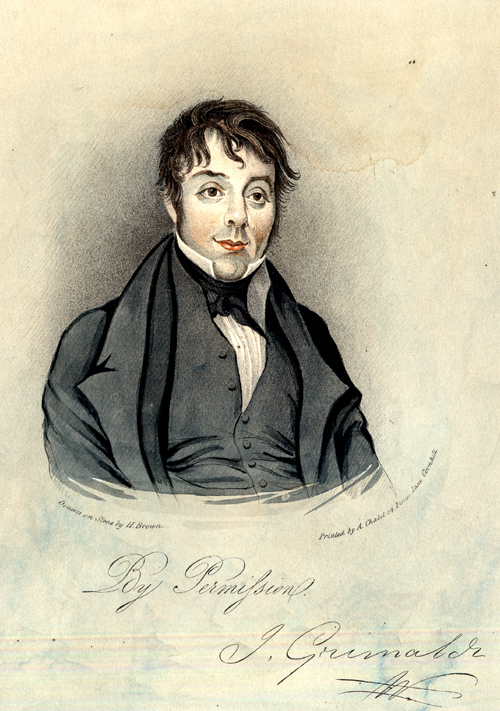
His Italian father, Giuseppe Grimaldi (d.1788), a ballet-master, dancer and pantaloon, first appeared in London at the King’s Theatre (now Her Majesty’s Theatre) in the Haymarket. Grimaldi’s mother, Rebecca Brooker, danced and played bit parts at the Theatre Royal, Drury Lane and at Sadler’s Wells theatre in Clerkenwell.
Debut at Sadler’s Wells
Joseph Grimaldi’s first appearance, as a child dancer at three-years-old, was in the pantomime Pandora’s Box at Sadler’s Wells with his father on 16 April 1781. Young Joe regularly performed at the Wells; in 1794 he played the dwarf in Valentine and Orson, as well as appearing in various French-revolutionary dramas then drawing large crowds to the theatre.
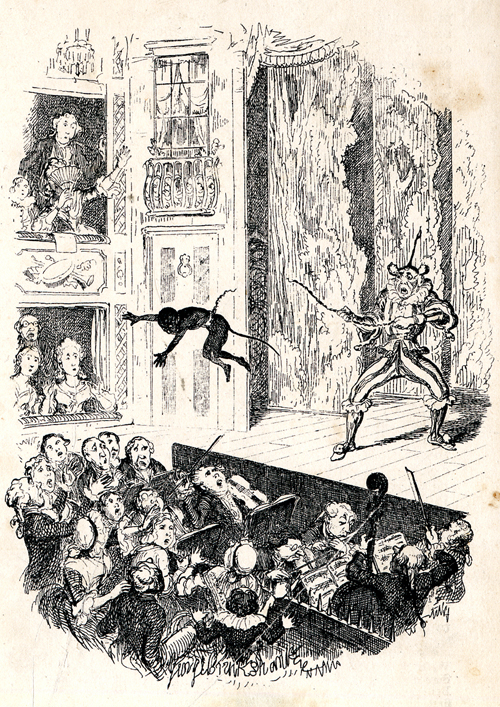
Guzzle the Drinking Clown
Grimaldi’s first performance as a clown took place at Sadler’s Wells in 1800. He played ‘Guzzle the Drinking Clown’ in an innovative pantomime called Peter Wilkins (or Harlequin in the Flying World) written by dramatist and theatre proprietor Charles Dibdin (the younger). Joseph or ‘Joey’ was dressed in an extravagant, multi-coloured costume and his make-up featured a white face, decorated by two red half-moons on each cheek rather than the traditional ruddy complexions of 18th-century clowns. Grimaldi became so popular in the harlequinade that the name ‘Joey’ has passed into the English language to mean clown.

King of Clowns
Grimaldi rapidly began to be celebrated as the unchallenged king of clowns. In the years that followed he played assorted comic and tragi-comedic parts. These included more performances at Sadler’s Wells, including ‘Friday’ in Robinson Crusoe (1802) and, famously, the ‘Wild Man’ in Charles Dibdin’s aqua-drama The Wild Man (or Water Pageant, 1809), written especially for him.

He was to transform the clown from a rustic fool into the star of metropolitan pantomime. To the delight of audiences, his clown possessed no respect for property, propriety or authority. He was high-spirited, mischievous and amoral, satirising contemporary British society and ridiculing the Regency period.

Mother Goose
One of Joseph Grimaldi’s greatest successes was his performance in Harlequin and Mother Goose (or The Golden Egg) a Christmas pantomime written by Thomas Dibdin, brother of Charles Dibdin, and performed at the Theatre Royal (later Royal Opera House), Covent Garden, in 1806. The piece became the most successful pantomime ever staged at the theatre. In the years to follow, Grimaldi built on his success with further characterisations at both Covent Garden and Sadler’s Wells. Critics often remarked on the almost demonic quality of Grimaldi’s mime and the expressiveness of his face and gestures.
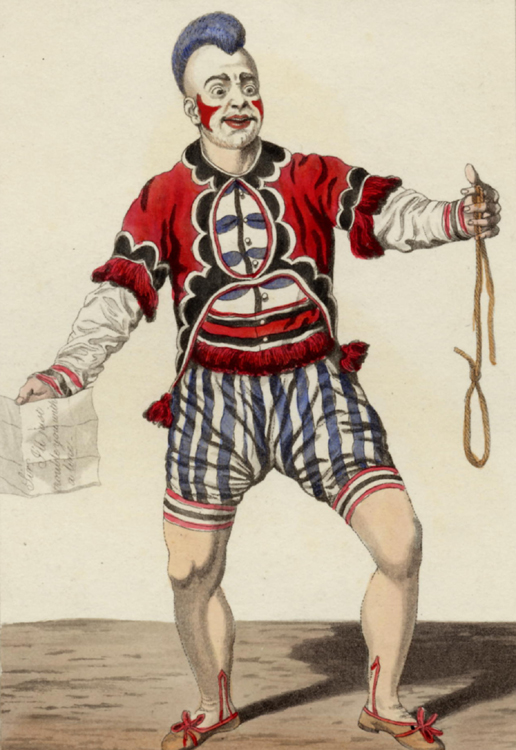
Exmouth Market
Joseph Grimaldi left Sadler’s Wells in 1816 and went on a very profitable tour of the provinces; he returned to the Wells in 1818 having bought a share in the theatre. The same year Grimaldi moved to nearby 8 Exmouth Street (now 56 Exmouth Market), Clerkenwell, and he lived there for ten years.
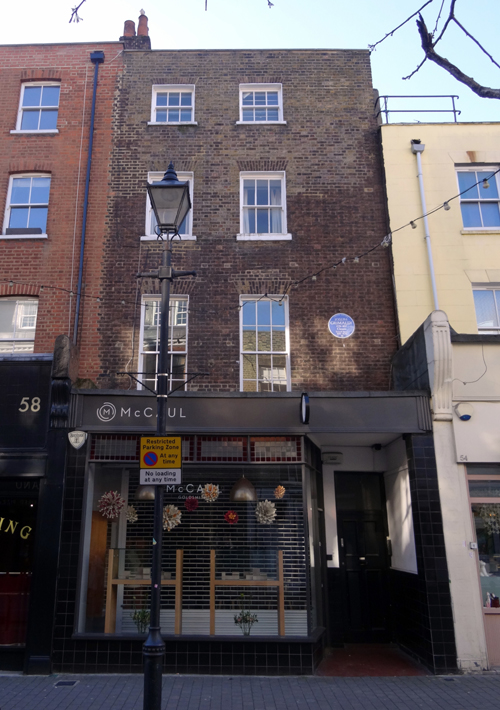
The clown’s health had been declining for some time and by the mid-1820s he had become almost completely disabled. By 1828 Grimaldi had become penniless and benefit performances for him were held at Sadler’s Wells and Covent Garden.

Joseph Grimaldi Park
Grimaldi’s only son, Joseph Samuel William Grimaldi (b.1802), who took over some of his father’s roles and had seemed to be full of promise, had become wild and uncontrollable and drank himself to an early death in December 1832. Grimaldi himself died on 31 May 1837 at 33 Southampton Street (later 22 Calshot Street), Islington, now demolished. He is buried in the nearby graveyard of St James’s Chapel, Pentonville Road.
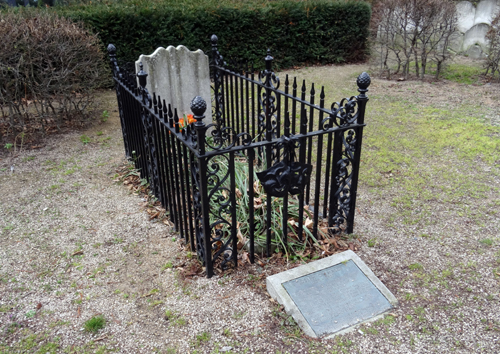
The burial ground located in Collier Street, in which the clown’s headstone can still be seen, is now called Joseph Grimaldi Park. In 2010 a coffin-shaped musical memorial dedicated to Grimaldi, made of bronze, musical floor tiles, was installed in the park; the tiles are tuned so that when danced upon it is possible to play his famous song Hot Codlins.
The Clowns’ Church, Hackney
Joseph Grimaldi continues to be remembered in an annual memorial service on the first Sunday in February at either Holy Trinity Church (the ‘Clown’s Church’) or All Saints Church in Hackney*. The service, which has been held since the 1940s, attracts hundreds of clown performers from across the world; the vestry of the church is also home to the Clowns Gallery-Museum, which includes the Clown Egg Register. Clowns attend the annual service in full clown costume, all paying their respects to Joseph Grimaldi, the Clerkenwell king of clowns and the father of modern clowning.
*Due to the Covid-19 Pandemic, this year’s service (2021) may be subject to special conditions or possible postponement, so please check with the churches for details.
Mark Aston
Islington Local History Centre | Islington Museum 2021
Further reading and online sources
Dennis Arundell The Story of Sadler’s Wells, 1683–1964 (Newton Abbott: David and Charles, 1978)
Julia Atkinson The Golden Age of Pantomime: Joseph Grimaldi to Dan Leno: from ‘The Era’ and other contemporary newspapers (Julia Diane Atkinson, 2019)
Charles Dickens Memoirs of Joseph Grimaldi (1837)
Richard Findlater Grimaldi King of Clowns (Magibbon & Kee, 1955)
Andrew McConnell Stott The Pantomime Life of Joseph Grimaldi: Laughter, Madness and the Story of Britain’s Greatest Comedian (Canongate Books, 2010)
Arthur Lloyd.co.uk (The Music Hall and Theatre History Site)
Italians in Islington (Islington Life / London Borough of Islington)
Sadler’s Wells Theatre Archive (Islington Local History Centre)
The Story of circus (Victoria and Albert Museum)

Leave a comment